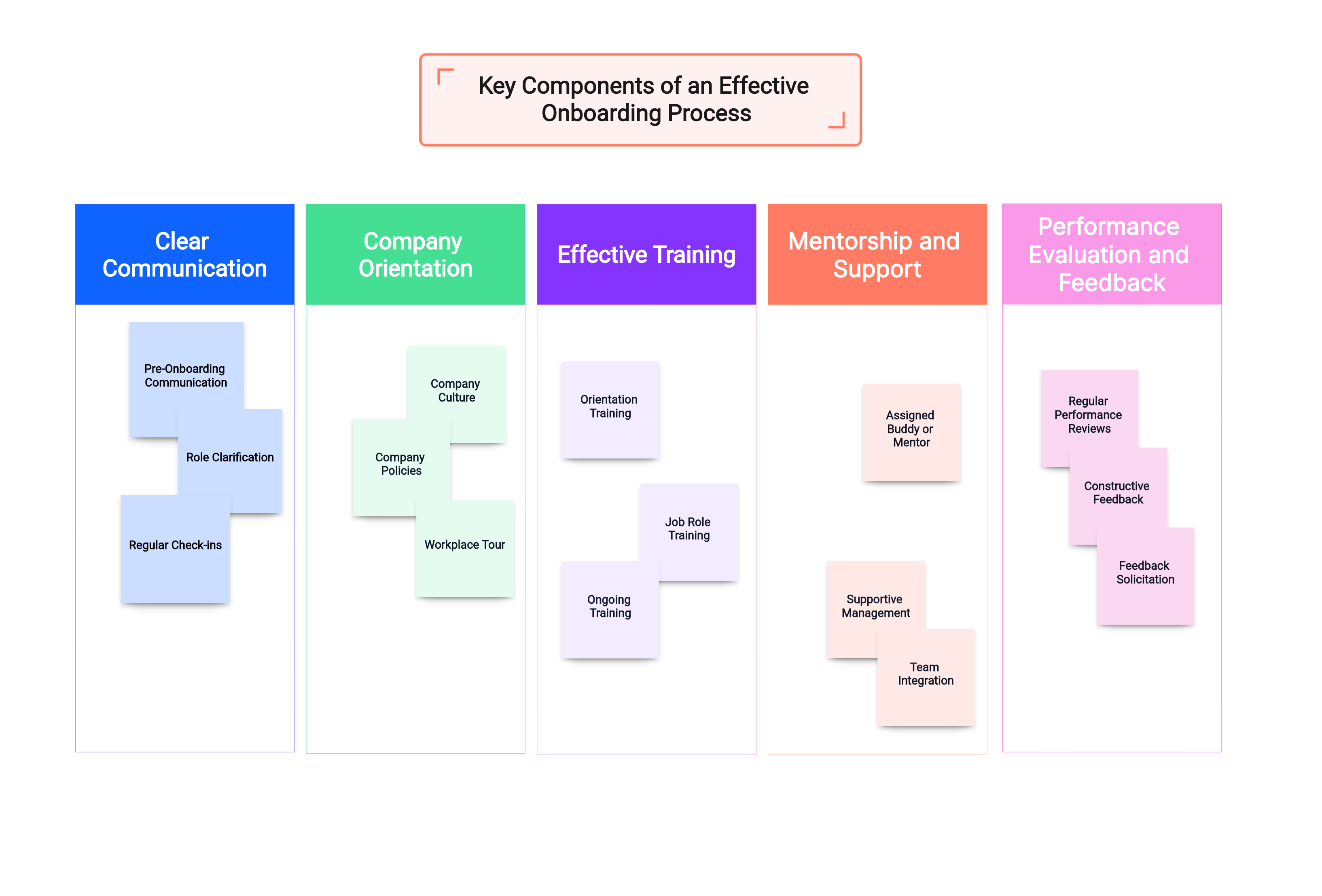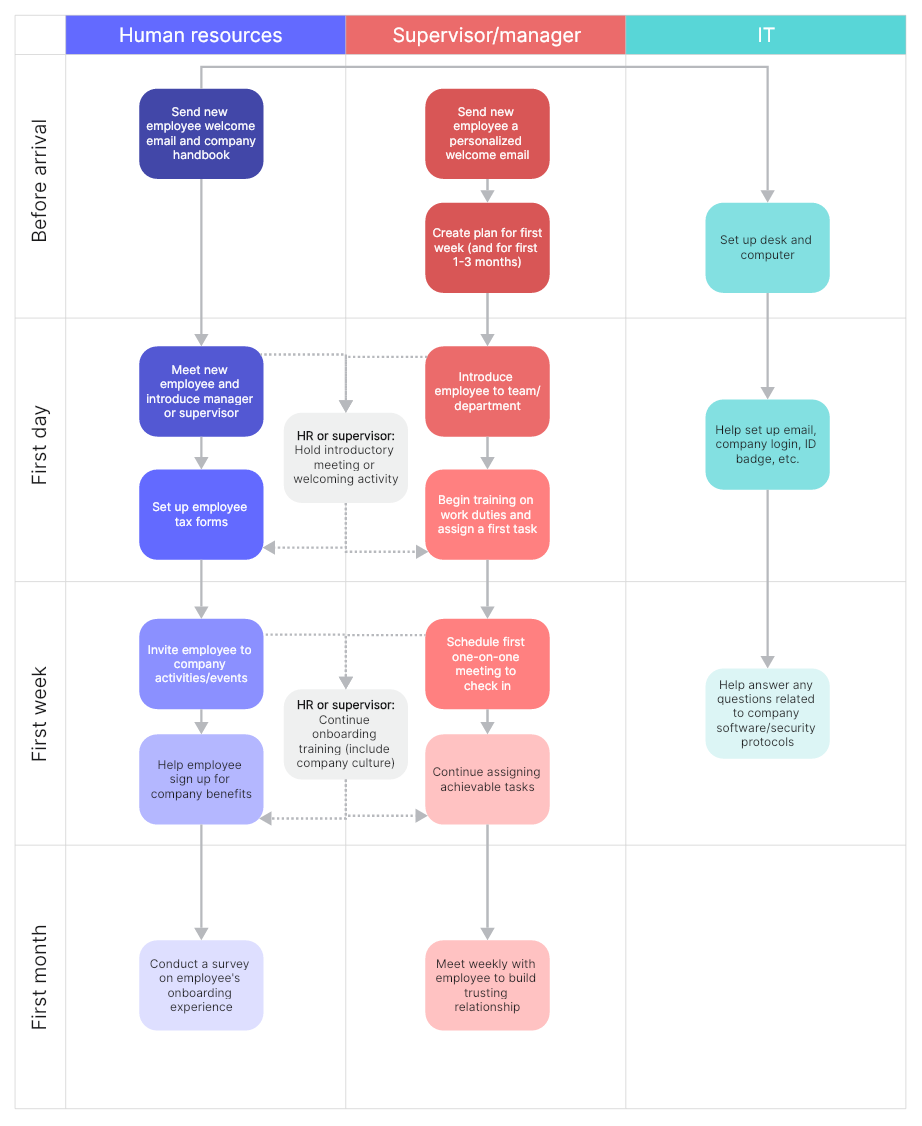Employee onboarding - a term well recognized, yet often misunderstood, is more than just a buzzword. It is a strategic process that can significantly impact the productivity, performance, and retention of your employees. In this comprehensive guide, we will delve into the depths of an effective employee onboarding process and shed light on how to create an immersive experience for your new hires.
What Is Onboarding in HR?
Onboarding, within the realm of Human Resources (HR), refers to the procedure of integrating new employees into the organization and providing them with the necessary tools, skills, and knowledge to become productive members. This systematic process extends beyond paperwork and includes various activities to familiarize new hires with the job role, company culture, and organizational goals.
What Is Employee Onboarding?
Employee onboarding, a crucial subset of HR onboarding, focuses on transitioning new recruits from applicants to active contributors within the team. It involves activities aimed at helping the new hire understand their job role, responsibilities, and performance expectations. More importantly, it forms the first impression of the organizational culture and work environment, thus having a profound impact on employee engagement and productivity.
Why an Efficient Onboarding Process is Necessary
A well-executed onboarding process does more than just ushering in new employees; it plays an integral part in employee retention and job satisfaction. A good first impression can lower early turnover rates while fostering job satisfaction and performance levels. Moreover, an organized onboarding process communicates the company's commitment towards employee success, paving the way for loyalty and long-term engagement.
Key Components of an Effective Onboarding Process
An effective onboarding process is much more than just a checklist of tasks to be completed. It's a comprehensive approach that aims to welcome new employees, acquaint them with their roles, and integrate them into the company culture. Here are some key components that make an onboarding process effective:
Clear Communication
Open, consistent, and clear communication is a critical component of an effective onboarding process:
- Pre-Onboarding Communication: Send regular updates and necessary information to the new hire before their first day.
- Role Clarification: Clearly communicate the job responsibilities, expectations, and performance parameters.
- Regular Check-ins: Keep communication lines open by scheduling regular check-ins to address any questions or concerns.
Company Orientation
Orientation sessions are an excellent opportunity for new hires to familiarize themselves with the company:
- Company Culture: Conduct sessions about the company's mission, vision, values, and goals.
- Company Policies: Provide information about HR policies, code of conduct, and other significant company policies.
- Workplace Tour: Give a thorough tour of the premises highlighting important locations.
Effective Training
Structured training sessions are essential for helping the new employee hit the ground running:
- Orientation Training: Initial training sessions should be focused on familiarizing them with company-specific software, tools, and protocols.
- Job Role Training: Provide detailed training about their specific job role to enable them to perform effectively.
- Ongoing Training: Keep up-to-date with the latest industry trends and offer continuous learning opportunities.
Mentorship and Support
A supportive environment can significantly improve a new hire's experience:
- Assigned Buddy or Mentor: Assign a seasoned employee to act as a mentor for the new hire.
- Supportive Management: Managers should be approachable and supportive, providing guidance whenever needed.
- Team Integration: Encourage team members to include the new employee in work discussions as well as social events.
Performance Evaluation and Feedback
Evaluations and feedback are essential for employee growth:
- Regular Performance Reviews: Conduct performance reviews at regular intervals, starting from the end of the first month.
- Constructive Feedback: Provide constructive feedback focusing on their strengths and areas for improvement.
- Feedback Solicitation: Encourage new employees to give their feedback about their onboarding experience and make necessary improvements.
Inclusion of these elements makes the onboarding process a strategic function that positively impacts the new hire's productivity, satisfaction, and long-term retention in the organization.

A Step-by-Step Guide to Implementing an Onboarding Process
The task of creating and implementing an effective onboarding process may seem overwhelming, but with a structured approach and careful execution, it becomes manageable. Here is a detailed, step-by-step guide for a modern onboarding process in 2023.
Pre-boarding Phase
The onboarding journey begins even before the new hire's first day.
- Employment Paperwork: Handle all required paperwork such as contracts, forms, benefits enrollment, etc. digitally, reducing the administrative burden on their first day.
- Orientation Kit: Prepare and send an orientation kit containing essential details about the company, team, work environment, and job role.
- IT Setup: Collaborate with your IT department to ensure all necessary equipment and accounts (email, software access) are set up in advance.
- Introduction Mail: Introduce the new employee to their team through a welcome email to foster initial connections.
First Day at Work
The first day should make the new employee feel welcomed and valued.
- Warm Welcome: Organize a warm welcome – a friendly greeting, small welcome gift, or a team breakfast can set the right tone.
- Company Tour: Provide a tour of the premises, highlighting essential areas such as restrooms, cafeteria, and emergency exits.
- Meet the Team: Arrange formal introductions with immediate team members and key personnel in the organization.
- Job Role Orientation: Give an overview of their job responsibilities and performance expectations.
First Week at Work
The first week is about orientation and initial training sessions.
- Training Schedule: Start with initial training sessions on company-specific software and tools. This could include everything from communication tools to project management software.
- Company Policies: Arrange sessions to educate them about important company policies – attendance, code of conduct, etc.
- Culture Introduction: Conduct workshops or sessions showcasing your company culture, values, mission, and goals.
- Regular Check-ins: Check-in daily to address queries, concerns or issues the new employee might be facing.
First Month at Work
The first month should focus on performance evaluation and feedback.
- Role-specific Training: Initiate in-depth role-specific training to help them perform their job effectively.
- Performance Assessment: Carry out a performance evaluation at the end of the first month to provide constructive feedback.
- One-on-one Meetings: Arrange one-on-one meetings with their manager to discuss performance, understand concerns, and discuss career progression.
Beyond First Month
Onboarding is an ongoing process that goes beyond the first month.
- Continuous Learning Opportunities: Offer ongoing learning and development programs related to their field of work.
- Regular Feedback: Make performance reviews and feedback a regular practice.
- Career Development Discussion: Have discussions regarding their long-term career goals and ways to achieve them within the organization.
- Employee Engagement Activities: Involve them in company-wide activities, celebrations, social gatherings to ensure they feel part of the team.
Each step is designed to engage new employees effectively, minimize confusion, and ensure they feel valued, boosting their productivity and commitment to the organization. This is not a one-size-fits-all guide, and organizations should personalize this based on their size, industry, and company culture. Remember that onboarding is an ongoing process and should be treated as such to ensure long-term success and growth.

Tips and Best Practices for Successful Employee Onboarding
Creating an enriching onboarding experience demands more than sticking to a standard protocol. It requires thoughtful planning, personalized approach, and regular updates to stay relevant. Here are some proven tips and best practices that can significantly enhance your employee onboarding process:
Customize the Onboarding Experience
Personalization is a powerful tool that can significantly improve the onboarding experience. Here's how you can incorporate it:
- Role-Based Orientation: Design the program based on the role of the new hire. For example, a sales executive would require different training than a software engineer.
- Experience-Based Training: Cater to the previous experience of the new hire. A fresh graduate might need more hand-holding and mentoring compared to a seasoned professional.
Stretch Onboarding Beyond First Week
An onboarding program confined to the first week can be overwhelming for new hires and might not cover all aspects of their job role. Here's how you can extend it:
- 30-60 Day Plan: Develop a detailed 30-60 day onboarding plan. This allows for gradual learning and better understanding.
- Milestone-Based Check-ins: Implement milestone-based check-ins during the first 6 months to provide consistent support and feedback.
Implement a Buddy System
Buddy systems can help the new employee adjust faster:
- Assign a Buddy: Pair the new hire with a seasoned employee who can help them navigate through their initial days at work.
- Team Integration: Encourage team members to include the new employee in work discussions as well as social gatherings.
Gather and Implement Feedback
Continuous improvement is key for an effective onboarding process. Here's how you can gather and implement feedback:
- Feedback Sessions: Conduct feedback sessions with new hires after 30, 60, and 90 days to understand their onboarding experience.
- Process Improvement: Use this feedback to identify gaps in your current onboarding process and implement necessary changes.
Leverage Technology
Technology can make the onboarding process smoother and more engaging:
- Digital Paperwork: Use online forms for all official documentation to save time and reduce hassle.
- Online Learning Management Systems: Use online LMS for all training sessions allowing new hires to learn at their own pace.
- Virtual Reality: Innovative technologies like VR can be used for virtual tours of office premises or simulated job role training.
Remember, every organization is unique, and so is each employee. The key lies in aligning your onboarding program with your organizational goals while catering to the individual needs of your employees, ensuring they feel valued, engaged, and ready to perform their best.
Visualize and Update Your Onboarding Process with Boardmix
Having covered all aspects of an effective onboarding process, it's time to put this knowledge into action. Boardmix offers built-in onboarding process flowchart templates to visualize your process, making it easy for everyone involved to understand their role in this process. With its key features, you can constantly update and improve your onboarding process.
The journey of your new hires, from orientation to becoming valuable team members, is shaped by their onboarding experience. Design an effective onboarding process with Boardmix and set your new hires on a path of productivity and success from day one.








